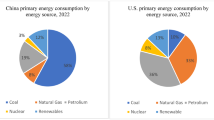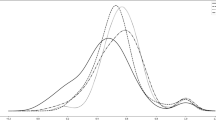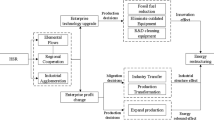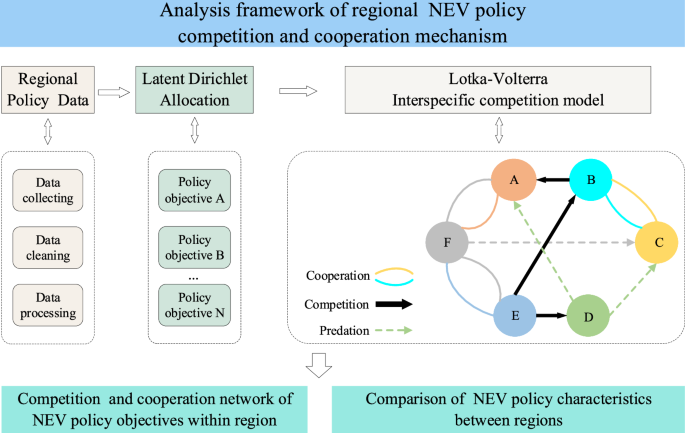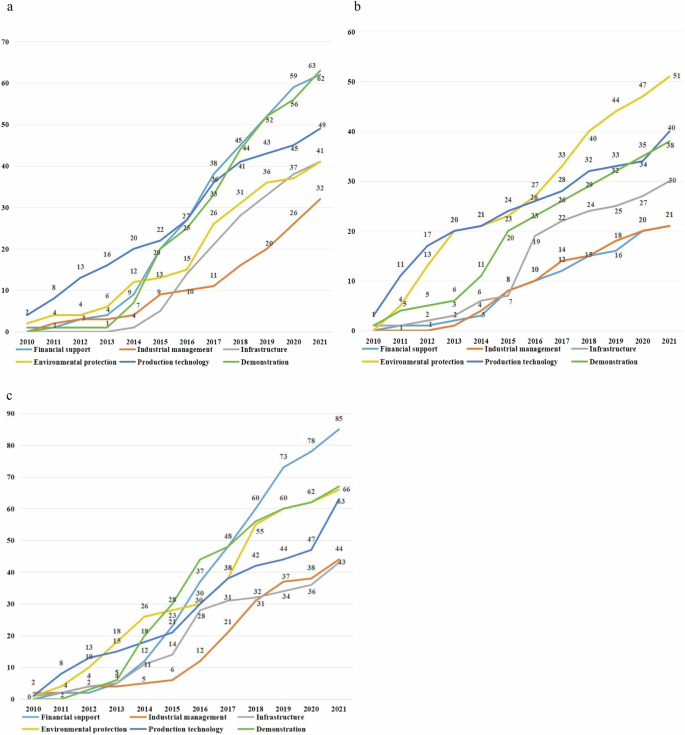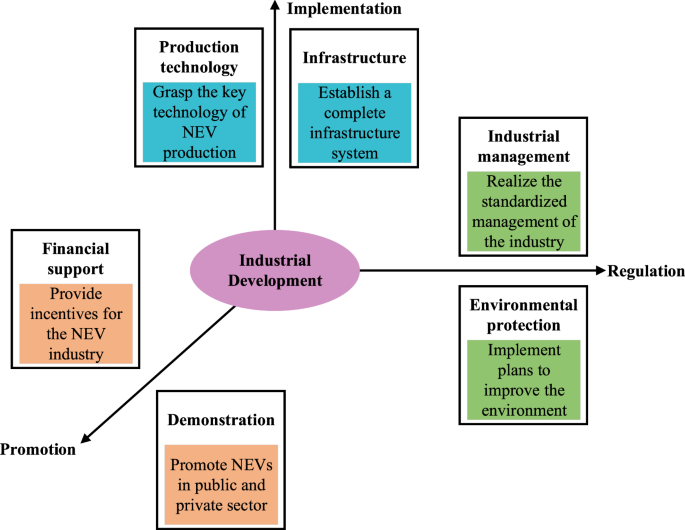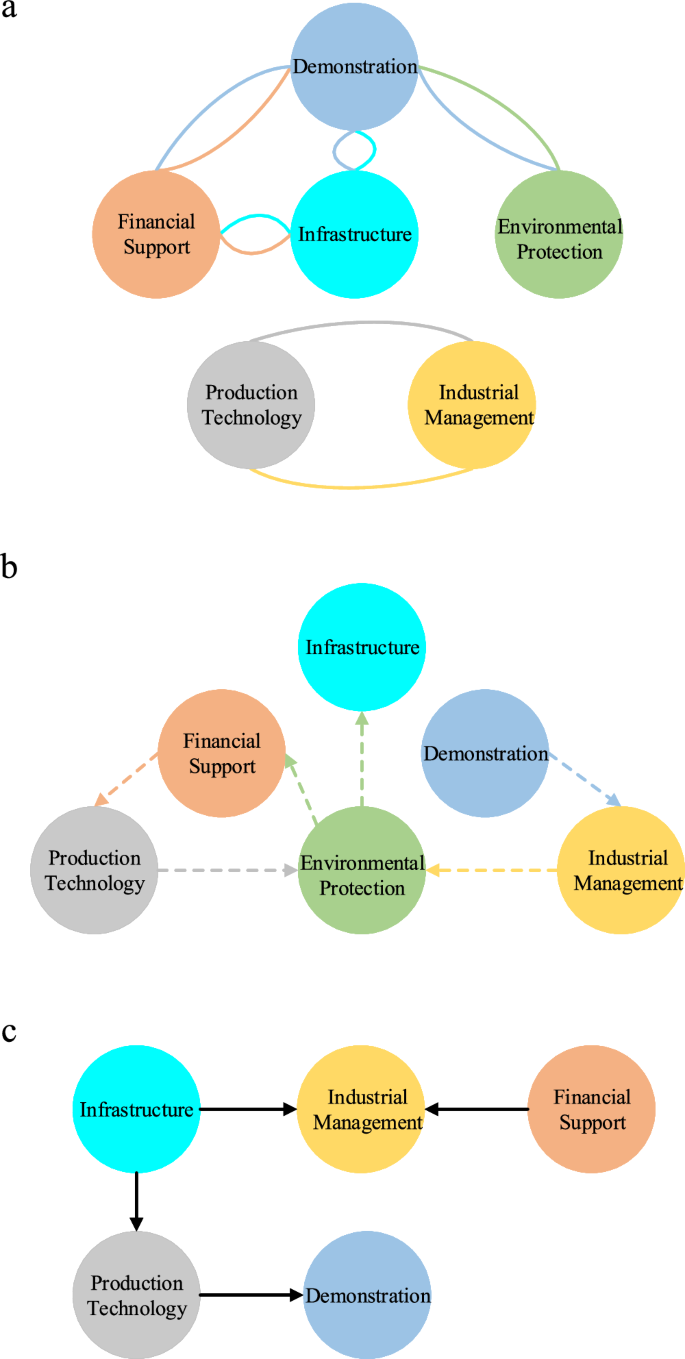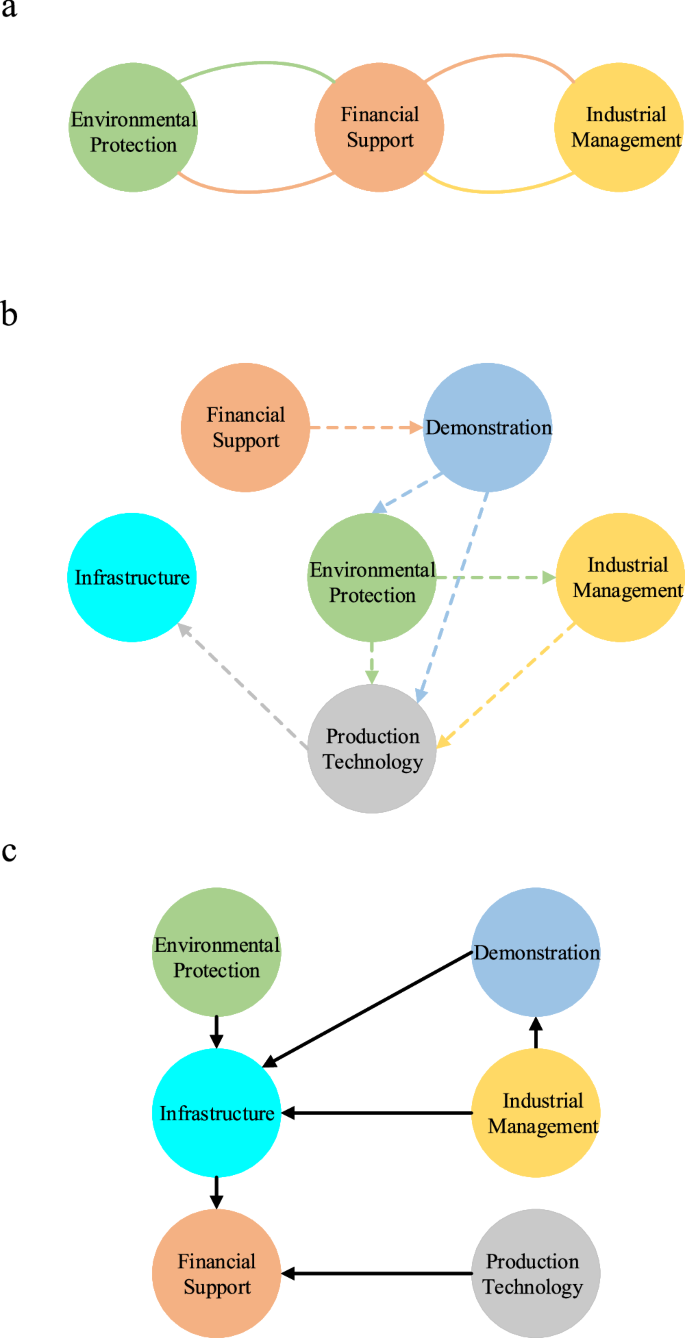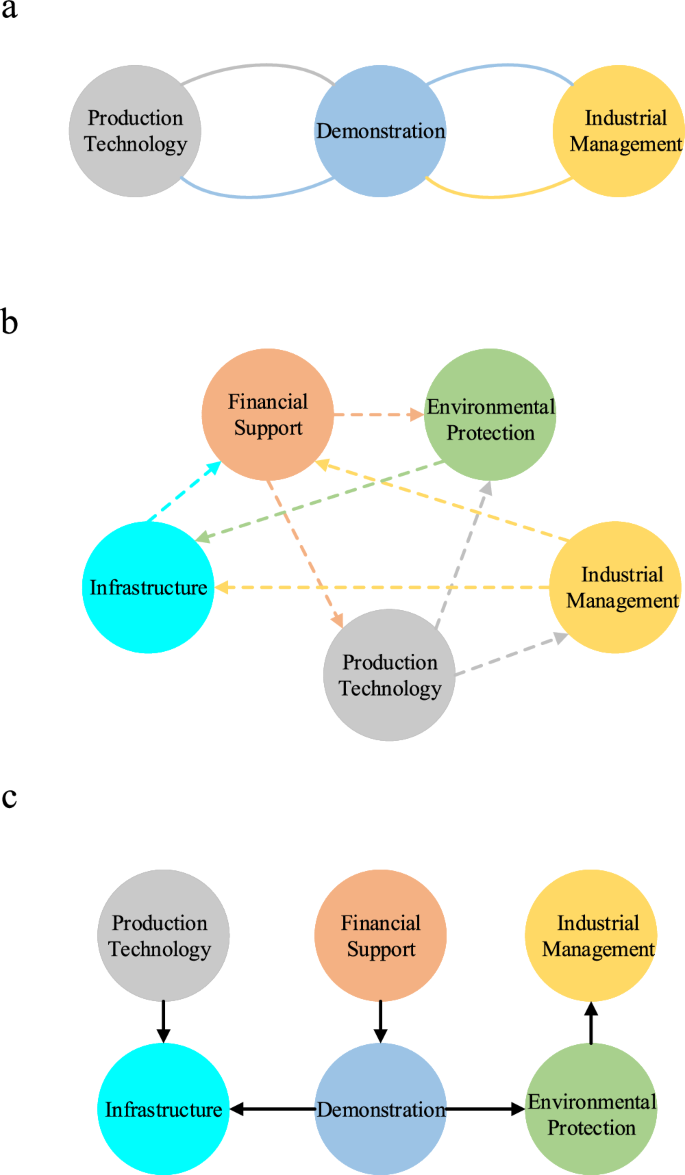Abstract
New energy vehicles (NEVs) are crucial in addressing environmental pollution and energy shortages. Their widespread adoption has been hindered by challenges such as inadequate infrastructure and limited market competitiveness. To promote the development of NEV, local governments in China have implemented various policies. However, resource constraints within regions have created inherent conflicts among policy objectives, while regional disparities have emerged due to differences in development status and characteristics. This study aims to model the complex competitive and cooperative mechanisms among different NEV policy objectives and compare their variations across three key regions: the Beijing-Tianjin-Hebei (BTH), Guangdong-Guangxi-Fujian (GGF), and Yangtze-River-Delta (YRD). Firstly, topic model Latent Dirichlet Allocation is applied on 857 local NEV policies from 2010 to 2021, identifying six core policy objectives, namely production technology, infrastructure, financial support, demonstration, industrial management and environmental protection. Then, the Lotka-Volterra model is employed to examine competitive and cooperative mechanism among these policy objectives. Key findings are: (1) infrastructure policies prevail across all regions; (2) regulation policies exhibit a comparative advantage in the BTH region, while implementation policies dominate in the GGF region and promotion policies in the YRD region; (3) cooperation among objectives is primarily observed in the BTH region, whereas competition plays a more dominant role in the other regions. This study fills a previous research gap and provides insights for researchers and policymakers, highlighting the development of customized strategies that consider the unique characteristics and requirements of each region.
Similar content being viewed by others
Introduction
The world has witnessed rapid global economic development and a significant increase in energy demand. This growth has come with several negative consequences, including increased environmental degradation and energy shortages. As an important measure to address these challenges, new energy vehicles (NEVs) have received widespread attention (Zhang et al. 2020). Through their utilization of clean energy sources, NEVs help reduce carbon emissions, improve air quality, and contribute to a more sustainable transportation sector (Tan et al. 2018; Wang et al. 2021). By promoting the adoption of NEVs, countries can mitigate environmental impacts, reduce dependence on fossil fuels, and work towards a more sustainable future (Guo et al. 2022; Li et al. 2019).
To effectively guide the development of NEV in China, the government has implemented a range of policies that provide comprehensive support (Liu et al. 2023). The NEV industry has been an integral part of China’s national strategy for several years (Lin and Shi, 2022). Strategic high-tech objectives, such as the “National High Technology Research and Development Program (1983–2016)”, have identified the NEV industry as a priority (Liu and Kokko, 2013). Subsequently, the number of NEV-related programs has increased annually. Pilot schemes, including “Ten Cities, Thousand Vehicles (2009–2012)” initiative, were introduced to promote NEV adoption in the public sector. Upon these initiatives, local governments have also implemented many policies encompass technology support, subsidies, infrastructure, and demonstration, to facilitate comprehensive NEV industry growth. The rapid development of NEV industry greatly depends on strong policy support.
However, the nationwide promotion and adoption of NEV still face multiple challenges. Firstly, significant disparities across different regions exist, such as the level of infrastructure (Dong and Liu, 2020). Insufficiency infrastructure development hinders NEV progress in some areas (Kalthaus and Sun, 2021). Additionally, there is a lack of effective coordination and collaboration between local policy responses and central planning. While some regions have implemented proactive policies such as purchase subsidies and free parking to support NEVs, others have not provided adequate incentives, which has resulted in slower local NEV adoption (Liu and Yi, 2020). Moreover, limited internal policy resources among regions and strong interrelationships between policy objectives create difficulties in formulating optimal strategies.
In recent years, scholars have conducted studies on NEV policies in multiple nations from various perspectives and methodologies. Ma et al. (2019) compared NEV policies in China, Japan, Germany, and the United States, finding that nations formulate NEV policies with different priorities, based on factors such as technological levels and market competitiveness. Wesseling (2016) revealed that nations with developed automotive industries prioritize technological advancement policies, whereas those with underdeveloped automotive industries emphasize NEV sales promotion. China’s NEV promotion strategy serves dual purposes: addressing climate change and advancing industrial technologies. Dua (2024) highlights the emerging discourse on policy-driven developments in achieving net-zero transport emissions, particularly relevant for emerging economies like China. Meckling and Nahm (2019) frames China as an “industrial upgrader”, aiming to develop an export-oriented EV industry while addressing environmental challenges. Dua et al. (2024) emphasizes the importance of assessing how various countries’ policies impact the competitiveness of their EV battery industries relative to China’s. In China, local governments are also encouraged to align subsidy policies with regional circumstances (Liu et al. 2022). Therefore, unique regional characteristics and policy differences have emerged. Zhang and Qin (2018) summarized provincial and municipal NEV policies, shedding light on the evolving policy emphases over time and across regions. Moreover, Haley (2015) found substantial regional NEV development variations, emphasizing the need for targeted, context-specific strategies. Similarly, Liu et al. (2022) examined regional differences in the promotion effects of China’s NEV policies, suggesting that inconsistencies in policy formulation and implementation have led to variations in policy effectiveness. The development of NEVs exhibits significant regional variations, primarily influenced by distinct policy objectives set by local governments, which serve as guidelines for action. Understanding these policy objectives is crucial for effective policy-making, as they reflect the government’s agenda and priorities. Consequently, the study of policy objectives has gained attention in NEV research. Scholars have explored various policy objectives, including technology investment, financial support, market subsidies, and infrastructure development (Liu et al. 2018; Du and Ouyang, 2017; Zhang and Cai, 2020; Li et al. 2016). These studies of multidimensional policy objectives have made substantial contributions to the development of the NEV industry.
Local governments face the challenge of balancing multiple policy objectives while formulating NEV policies. Different policy objectives can either compete or cooperate with each other due to limited regional resources. For instance, government efforts to encourage NEV adoption through financial subsidies can contribute to energy and environment objectives (Zhang et al. 2020). Recent studies examine the complex effects of electric vehicle subsidies. Sheldon and Dua (2020) found the impact and cost-effectiveness of the Chinese plug-in electric vehicle subsidy program, suggesting income-based targeting could improve efficiency. Li et al. (2022) noted that while subsidies drove over half of China’s EV sales, infrastructure investments were more cost-effective. Sheldon and Dua (2024) provided a global perspective, revealing subsidies’ costs across countries and demonstrating improved medium-term cost-effectiveness. Barwick et al. (2024) showed that attribute-based subsidies in China led to higher product quality and reduced market distortions compared to uniform subsidies. While subsidies are effective in stimulating NEV adoption, they also pose financial challenges for local governments. Ji et al. (2019) highlight the risks associated with excessive subsidy dependence, emphasizing the need for sustainable and diversified approaches to incentivize NEV adoption. This underscores the importance of finding a balance between promoting NEVs and ensuring fiscal sustainability. Local development statuses and resource endowments vary across regions, leading to diverse policy emphases. Zhang and Bai (2017) have analyzed regional NEV policies to identify common objectives, such as environment protection, infrastructure construction, and industrial revitalization. For example, Shang et al. (2024) mentioned that provinces like Guangdong are keen to expand infrastructure construction. Moreover, Sun et al. (2020) found that promoting green consumption awareness among consumers and fostering environmental consciousness among enterprises are crucial for reducing carbon emissions in the transportation sector of the Yangtze River Delta region. Zhu et al. (2021) highlight the complementary nature of NEV subsidies and regulations under different conditions. Understanding how various policies interact and complement each other is essential for maximizing their effectiveness and minimizing unintended consequences, such as potentially hindering technological breakthroughs in the long term (Zhang and Bai, 2017). While insights gained from existing studies, there remains a lack of a unified comparative policy formulation framework. This gap underscores the need for further research to develop comprehensive approaches that consider the mechanisms of multi-objective operation. Such framework would enable policymakers to navigate the complexities of balancing competing objectives more effectively and guide coordinated and sustainable development efforts at region level.
In recent years, computational methods for textual analysis have gained popularity. While qualitative analysis has been the predominant approach for examining NEV policies (Liu and Kokko, 2013), its reliance on experience limits its ability to process extensive and large-scale datasets. Consequently, computational algorithms for text analysis have been increasingly employed (Isoaho et al. 2021). Among these methods, topic modeling Latent Dirichlet Allocation (LDA) is a computational technique that automatically analyzes and uncovers hidden semantic structures within a collection of documents (Hu et al. 2024). It has been widely used in text analysis to identify hidden topics in a corpus with a probabilistic model (Isoaho et al. 2021). As an automated data clustering method, LDA extracts the main themes contained in large, unstructured documents (Blei et al. 2003). LDA enables the tracking of topic evolution over time, facilitating the detection of significant changes and providing valuable insights into the dynamics of themes (Isoaho et al. 2021; Shi et al. 2022). Li et al. (2021) combined LDA and econometric models to explore the impact of NEV policies. Given its capacity to interpret policy texts, we employed the LDA topic model in conjunction with text analysis to investigate China’s NEV policies.
To quantitatively characterize the complex relationships among various objectives, theoretical competition-cooperation models from biology have gained widespread attention, especially the Lotka-Volterra (LV) model. The LV model is a mathematical framework that captures how the population of one species affects and is affected by others, accounting for both positive (cooperative) and negative (competitive) interactions. It excels at describing complex relationships, competitive and cooperative dynamics, and temporal evolution of multiple variables in a system. This flexibility allows the model to represent both micro-level interactions and macro-level system dynamics, extending its applicability from ecology to diverse social and economic fields. For instance, Zhang and Huang (2021) utilized the LV model to analyze the competitive and cooperative dynamics between technological innovation, resource consumption, environmental quality, and industrial development quality. Similarly, Mao et al. (2020) employed the LV model to quantify and predict the relationships between commercial bank online payment systems and third-party online payment systems. Their analysis revealed the dominance of competition in these relationships. These theoretical models have expanded into various domains, including product market competition, population dynamics, economic growth, pollution emissions and energy consumption (Hung et al. 2014; Tsai and Chen, 2020; Zhang et al. 2023).
The broad applicability of the LV model demonstrates its power as a valuable framework for policy analysis. The policy objectives interact similarly to species. First, the growth dynamics in policies like the intrinsic growth of species populations, influenced by factors such as political support and resource allocation. Second, interaction effects capture how policies can compete for resources or attention, or complement and reinforce each other, similar to species interactions in ecosystems. Third, temporal evolution is considered, as both species populations and policy emphases change over time. Finally, the model’s capacity to handle system complexity allows for the analysis of multiple interacting policies. The LV model provides a systematic framework for analyzing complex interactions among multiple policy objectives simultaneously. This dynamic approach allows for the analysis of both competitive and cooperative elements within the policy ecosystem.
To enrich the understanding of complex policy system and the interconnectedness among different policy objective, this study proposes a quantitative framework based on the Lotka-Volterra model. The framework aims to examine the competitive and cooperative relationships among various objectives within the context of NEV policies. By investigating the interrelationships among policy objectives, valuable insights can be gained into the dynamics that drive policy outcomes and decision-making processes. To carry out the analysis, a dataset of 857 local NEV policies from the past decade was collected, focusing on three key regions in China. The policies were applied in the LDA model, a technique used to extract and quantify the NEV policy objectives present in the dataset. This objective data was then utilized to construct a multi-objective LV model, which captures the complex interactions among the identified objectives. The model was solved using partial differential equations through grey estimation, enabling the exploration of the competition-cooperation spectrum within the NEV policy system. This approach allows for the identification of regional policy development traits and facilitates comparative analysis of policy implications across the studied regions. Overall, this framework provides a systematic approach to understanding the competitive and cooperative dynamics among NEV policy objectives. By employing the LV model and leveraging quantitative analysis techniques, this study contributes to the knowledge and decision-making processes in the realm of NEV policies, offering policymakers valuable insights for policy optimization and effectiveness.
The structure of this paper is as follows: Section “Introduction” provides the background introduction and literature review. Section “Methods” describes the methodology, including the research design and data sources. Subsequently, Section “Result” presents the experimental results, providing a descriptive and analytical study of NEV policy objectives, along with analysis of their competitive and cooperative relationships. Section “Discussion” discusses the finding of research. Finally, Section “Conclusions” presents conclusion, policy implication and limitations.
Method
Research framework
In order to address the need for local governments to effectively balance multiple policy objectives of NEV policies, this paper proposes a competition-cooperation perspective to examine the dynamics among these objectives. The research framework is illustrated in Fig. 1. The first step of the framework involves applying LDA topic modeling to identify the key policy objectives from a collection of local policy texts. This computational text analysis technique helps recognize the most relevant and prevalent objectives within the corpus. The frequency of objective occurrence is then summarized, providing insights into the relative prominence of each objective. Next, the Lotka-Volterra model is employed to analyze the competitive and cooperative relationships among the identified policy objectives. In this model, the objectives are treated as “species” and their frequency of occurrence is analogous to population size. By applying the LV model, the interactions among policy objectives are quantified, and a relationship network of policy objectives is constructed. This approach allows for a quantitative exploration of the relationships between different objectives, shedding light on the competitive and cooperative dynamics among them. By combining computational text analysis with ecological modeling, this novel approach offers a data-driven framework to understand the complex dynamics between local NEV policy objectives. It provides insights into how local governments navigate the competing objectives when formulating NEV policies. The framework enhances the understanding of the decision-making processes and strategies employed by local governments to balance the various objectives and promote effective policy outcomes in the NEV industry.
Data source
In this study, three provincial regions were selected as the research area: Beijing-Tianjin-Hebei (BTH), which includes Beijing, Tianjin and Hebei Province; Guangdong-Guangxi-Fujian (GGF), consisting of Guangdong Province, Guangxi Province and Fujian Province; and Yangtze-River-Delta (YRD), which contains Shanghai, Zhejiang Province, Jiangsu Province and Anhui Province. These regions were chosen based on several considerations. Firstly, these regions, located along China’s eastern coast, represent the country’s most economically advanced areas and have experienced the full trajectory of China’s NEV industry evolution. The NEV industry in these regions has developed rapidly, benefiting from strong foundational advantages including pre-existing automotive and high-tech industries, access to capital, and a skilled workforce. After nearly a decade of growth, they have cultivated established ecosystems encompassing research and development centers, large-scale manufacturing clusters, well-developed supply chain networks, and infrastructure. Secondly, these regions also offer excellent representativeness of different aspects of China’s NEV policy landscape. BTH, as the northern region, represents the administrative and political core, often leading in policy innovation. YRD, the eastern region, exemplifies areas of robust economic development and industrial maturity. GGF, the southern region, is known for technological advancements and an export-oriented economy. This diversity allows this study to capture a range of policy characteristics. Furthermore, these regions have been at the forefront of NEV adoption nationwide, with provinces like Guangdong and Zhejiang leading the way. They have implemented a comprehensive range of supportive NEV policies early on, including R&D subsidies, manufacturing incentives, infrastructure development initiatives, and consumer-focused measures such as purchase subsidies and preferential privileges. This rich and diverse policy environment is crucial for our analysis, offering a unique opportunity for a comprehensive temporal study of competition and cooperation mechanisms within the NEV policy landscape.
To conduct a comprehensive study, we collected data from various sources, including official websites of local governments, the China Automotive Industry Association website, and Peking University Law Weapon (https://www.pkulaw.com/law). Time span of the study was set from 2010 to 2021. Key search words like “new energy vehicle”, “electric vehicle”, “Lithium-ion battery car” and “low-carbon vehicle” were used to identify relevant official documents including laws, regulations, notices, plans, and announcements. After carefully reviewing the collected data and removing duplicates, a total of 857 valid policies were obtained. The YRD region has 368 policies in total, accounted for most policies, followed by 288 in GGF and 201 in BTH. This large-scale dataset from major economic regions provides a rich foundation for understanding local NEV policy priorities and interactions in China.
LDA topic model
LDA is a probabilistic language model proposed by Blei et al. (2003). The probabilistic graph of the LDA model is shown in Fig. 2. LDA assumes that each document is a mixture of topics and each topic is a mixture of words. The generation process for each document m in a corpus D can be explained as follows:
(1) Randomly choose a distribution over topics.
(2) For each word in the document:
a) Choose a topic from the distribution of topics.
b) Choose a word from the corresponding distribution of the vocabulary.
The generative process for the LDA corresponds to the joint distribution of the hidden and observed variables:
(alpha) is the parameter of the document-topic prior distributions over ({theta }_{1:M})
(beta) is the parameter of the topic-word prior distributions over ({varphi }_{1:K})
({varphi }_{1:{rm{K}}}) are the topics where each ({varphi }_{i}) is a distribution over the vocabulary
({theta }_{1:M}) are the topics where ({theta }_{m}) is a distribution for document ({rm{m}})
({z}_{m,n}) is the topic assignment for word ({rm{n}}) in document ({rm{m}})
({w}_{m,n}) is the ({rm{n}}) th word for document ({rm{m}})
The identification of topics and words can be estimated by Gibbs sampling.
Lotka-Volterra model
The Lotka-Volterra model is an extension of the single-species logistic model that accounts for the interactions between multiple species. While the logistic model assumes that a species exists in isolation and its population dynamics are solely influenced by its own factors, the LV model recognizes that in nature, the evolution and development of a species are often influenced by the presence and interactions with other species. Therefore, giving consideration on competition and cooperation of multi-species by adding the interaction terms between different species, the LV model is as follows:
where ({x}_{i}(t)) represents the cumulative number of species (i) at time (t). ({a}_{i}) represents the intrinsic growth rate of species i, indicating its growth intensity without impact from other species (Anisiu, 2014). ({K}_{i}) indicates the maximum possible cumulative number of species (i), which is determined by the environment. ({b}_{{ij}}) is the interaction parameter which meausures the impact of j on i, namely the competition coefficient. A positive ({b}_{{ij}}) means that j has a promoting effect on the development of i, while a negative one indicates an inhibitory effect.
First, let ({alpha }_{i}={a}_{i}), ({beta }_{{ii}}=-frac{{alpha }_{i}}{{K}_{i}}), ({beta }_{{ij}}=frac{{b}_{{ij}}}{{K}_{i}}), Eq. (3) can be rewritten as:
Subsequently, the competition coefficients among policy objectives are estimated using gray estimation (Zhang and Huang, 2021). Based on the mapping relationship between gray derivatives and logarithmic coordinates, Eq. (4) can be discretized as :
Substituting the original data column when (t=)1, 2, …, n into Eq. (5), the matrix equation can be obtained:
where
Finally, substitute the coefficient value obtained by Eq. (7) into Eq. (4). The competition parameters can be obtained (Zhang and Huang, 2021). Then the relationships between species i and j are determined by their respective competition parameters ({beta }_{{ij}}) and ({beta }_{{ji}})(i ≠ j). According to the signs of ({beta }_{{ij}}) and ({beta }_{{ji}}), 7 possible relationships between them can be recognized (Mao et al. 2020; Zhang and Huang, 2021), as shown in Table 1.
In this study, policy objectives were recognized by LDA and considered as species in the policy system, while their frequencies were considered as the population. Then, LV model was applied to discover their competition and cooperation mechanism by calculating the cooperation coefficient on each other. The promotion and inhibition effects of each objective on others can be obtained from the competition coefficient. Finally, networks of policy objective relationship can be constructed.
Results
Identification of policy objectives
Six policy objectives related to NEV development were identified through LDA, including production technology, infrastructure, financial support, demonstration, industrial management and environmental protection. The definitions of these objective were presented in Table 2. Then, the accumulated frequency of policy objectives corresponding to each objective in different regions were summarized. Figure 3 present the policy objectives in YRD, GGF and BTH regions, respectively. In both the YRD and GGF regions, the policy objectives of Financial Support and Demonstration had the highest number of policies. In contrast, in the BTH region, the policy objective of Environmental Protection had the largest number of policies, with 51 policies identified. By analyzing the distribution of policy objectives in different regions, the insights into the regional priorities and focuses of NEV policies in China can be obtained, highlighting the varying emphases on different aspects of NEV development across the selected regions.
Obtainment of intrinsic growth rates and competition coefficients
As described in Section 2, based on the result of LDA, LV model was applied to provide insights into the competitive-cooperative relationships among the NEV policy objectives in the three regions. To examine the fitness of the LV model, the coefficient of determination (R²) and Root Mean Square Error (RMSE) for each policy objective in each region are calculated, as shown in Appendix A. Generally, the R² and RMSE values across all regions and policy objectives indicate that the LV model provides a good fit to the observed data. This suggests that the model captures a significant portion of the complex dynamics in NEV policy interactions.
To test the stability of the LV model, the sensitivity analysis method Sobol is employed using SALib (Iwanaga et al. 2022). It is a variance-based global sensitivity analysis technique that quantifies the contribution of each input parameter to the output variance of the model. The parameter ranges are set to ±10% of their original values. The SALib generates a set of parameter samples to efficiently explores the parameter space. The LV model is then run for each sample set, and outputs are collected. The sensitivity indices for parameters are computed by SALib’s analysis module. This analysis identifies the most influential parameters for each region’s model, as shown in the Appendix A, which lists the top 5 most sensitive parameters for each region. Notably, intrinsic growth rates (({{rm{alpha }}}_{1}-{{rm{alpha }}}_{6})) dominate the sensitivity rankings across all regions, with some variation in their relative importance. Competition coefficients (({{rm{beta }}}_{36},{{rm{beta }}}_{42},{{rm{beta }}}_{13})) appear in the top 5 for BTH and GGF, but not for YRD. When applying the LV model to analyze NEV policy dynamics, these key parameters should be given more attention.
Moreover, with the parameter samples generated earlier, the LV model is executed to obtain the outputs. According the distribution of these outputs, the 95% confidence interval (95% CI) of the outputs is estimated. Appendix A presents the estimated results for the year 2021, showing the true number of policy objectives and the corresponding 95% CI for each objective in each region. The results are stable, with the true number of policy objectives falling within the estimated 95% CI. Through the fitted LV model, this study obtained the intrinsic growth rates and mutual competition coefficients of the six policy objectives in the three regions, then judged their respective relationships through the method shown in Table 2. The intrinsic growth rates of the six policy objectives were shown in Table 3, while their competition coefficients in the three regions were displayed in the Appendix A, respectively.
Discussion
The relationship of policy objectives based on the industry
Policy objectives take mutually reinforcing actions to drive the development of the NEV industry. Based on the content and interaction of objectives, this study classified objectives into three categories: implementation, promotion and regulation, as described in Fig. 4. Each playing a specific role in supporting the growth of the industry: (1) Implementation focuses on establishing the physical foundation through production technology and infrastructure. The government initially prioritized production technology advancements to reduce costs and boost competitiveness (Liu et al. 2018). Additionally, infrastructure construction is crucial, particularly as the sales of NEVs increase. Adequate infrastructure, such as charging stations and supportive transportation networks, is necessary to facilitate the operations of NEVs effectively (Wei et al. 2023). (2) Promotion aims to stimulate the adoption of NEVs across public and private sectors via financial support and demonstration programs. Financial support enables necessary long-term investments in R&D and infrastructure that companies cannot solely afford. Demonstration programs, often subsidy-driven, create substantial demand in the public sector and attract individual purchasers (Wei et al. 2023). These programs serve to showcase the benefits and feasibility of NEVs, encouraging wider adoption. (3) Regulation objectives provide industry and environmental guidance through management policies and emission standards. The government enacted various regulations on quality, standardization, and emissions to ensure that NEVs meet certain criteria for performance, safety, and environmental impact (Zhang and Qin, 2019). The interaction among these three categories is essential for addressing key challenges. For example, cost reductions require joint implementation efforts on battery innovations and promotional subsidies (Tie and Tan, 2013). In summary, the effective combination of objectives across implementation, promotion, and regulation is crucial for the development of a thriving NEV market. By establishing a strong physical foundation, stimulating adoption through financial support and demonstrations, and providing industry and environmental guidance, policymakers can drive the growth of the NEV industry and support the transition to sustainable transportation.
Table 4 is a summary of objective relationships in the three regions, respectively. There are differences in the regions’ policy priorities and the structure of their policy interaction networks. The intrinsic growth rates of policy objectives vary across regions, indicating different focus areas. BTH prioritizes infrastructure and environmental protection, suggesting a focus on building a robust foundation for the NEV industry and the urgent need to address severe air pollution issues in BTH region. YRD, on the other hand, emphasizes demonstration and environmental protection, which may indicate a more advanced stage of NEV adoption and a stronger emphasis on sustainability. GGF’s focus on financial support could reflect its export-oriented economy and the need to boost industry competitiveness. These priorities likely stem from each region’s unique characteristics, including their industrial base, environmental challenges, and economic development.
The structure and complexity of policy interaction networks also differ across regions. BTH exhibits a more balanced network with 5 cooperative, 4 competitive, and 6 predatory relationships. This balance might indicate a more integrated approach to policy implementation in the capital region. In contrast, GGF and YRD show a stronger tendency towards competition and predation, with only 2 cooperative relationships each. This disparity could be attributed to varying levels of resource competition and policy coordination capabilities in each region.
Beijing-Tianjin-Hebei Region
Analysis of regional intrinsic coefficients
As shown in Table 3, the intrinsic growth rates provide insights into the untapped growth potential of each policy objective. Among these objectives, infrastructure exhibited the highest intrinsic coefficient in BTH, followed by environmental protection and industrial management. The high growth rate of infrastructure can be attributed to several factors. As the capital region, BTH benefits from substantial government funding for NEV-related infrastructure. The region’s compact urban structure and dense population present unique challenges, necessitating robust infrastructure to accommodate diverse transportation needs. Furthermore, the region’s demanding mobility requirements, including extensive travel and daily commutes, drive the need for a comprehensive and efficient charging network. These factors collectively contribute to the prioritization of infrastructure development in BTH’s NEV policies. Notably, the coefficient of demonstration was negative, indicating a negative growth trend. This could be due to BTH reaching a stage of market maturity where additional demonstration projects yield diminishing returns, signaling a policy shift towards more targeted implementation and regulation policies. Additionally, there might be a reallocation of resources from demonstration projects to other pressing needs such as infrastructure development and environmental protection, which show higher growth rates in the region.
Analysis of regional relationships network
According to Fig. 5a, the cooperation network can be divided into two components. One component connects industrial management and production technology, while the other component links demonstration, infrastructure, financial support, and environmental protection. Based on the competition coefficients, infrastructure emerges as the most promoted objective and occupies a dominant position in the network. It serves as a bridge between implementation and promotion policies.
Figure 5b illustrates the predation network, showcasing two distinct patterns. Firstly, environmental protection, financial support, and production technology engage in mutual predation. Secondly, demonstration-industrial management, environmental protection-infrastructure, and infrastructure-production technology form linear predation chains. Among these interactions, environmental protection has the most significant predation impact on infrastructure, while financial support acts as the strongest inhibitor of environmental protection. Once again, infrastructure emerges as a central component, highlighting its dominant role in the network.
Figure 5c presents the competition network among policy objectives. It is observed that there is mutual inhibitory competition among the objectives, except for environmental protection. Infrastructure experiences the strongest inhibitory competition from industrial management and production technology. However, it also competitively suppresses production technology and industrial management. Industrial management occupies a central position in the network, highlighting its competitive dominance. The competitive relationship between infrastructure construction, production technology, and industrial management likely reflects the complex interplay of supply and demand factors in the NEV market. Infrastructure development is crucial for increasing NEV adoption (demand-side), while production technology and industrial management improve NEV production and quality (supply-side). The observed competition might indicate a balancing act in resource allocation. When infrastructure lags, resources may shift towards its development to boost adoption. Conversely, when infrastructure is adequate, the focus may turn to production technology and industrial management to enhance production efficiency. This balancing act can create temporary tensions, such as when industrial management efforts slow down infrastructure expansion as the industry waits for standards to be set before large-scale deployment. However, these objectives appear to be in competition while actually being complementary in the long-term development of the NEV industry, aligning with economic principles of supply and demand rather than representing inherent conflicts.
In the BTH region, industrial management and infrastructure play dominant roles. Infrastructure holds a dominant position in both the cooperation relationship network and the predatory relationship network, while facing strong competition from industrial management and production technology. This dynamic reflects a balancing act between supply and demand factors.
Guangdong-Guangxi-Fujian Region
Analysis of regional intrinsic coefficients
From Table 3, promotion objectives show the highest growth intensity exhibited the highest intrinsic growth potential, while regulation objectives had the lowest. This observation aligns with the region’s booming automotive market and urgent sustainability challenges. With the region experiences rapid economic development, there is a pressing need to address the escalating environmental challenges while harnessing the significant potential of the NEV market. Promotion policies aim to stimulate consumer enthusiasm on NEVs and provide impetus for sustained market development. The NEV industry in the GGF region is primarily concentrated in Guangzhou and Shenzhen, with other supporting developments in the surrounding areas. The implementation of promotion policy measures has proven effective in cultivating the NEV industry, particularly in higher-income areas where they have a significant impact on sales volume (Xiong and Wang, 2020). Given this context, there is strong support for the development of promotion policies.
Analysis of regional relationships network
Only three objectives appear in the cooperation network: environmental protection, financial support, and industrial management, as shown in Fig. 6a. Among these, financial support serves as the central component, receiving significant promotion from environmental protection. To achieve the goal of carbon peak and carbon neutrality as well as alleviate environmental pollution pressures, it is necessary to establish a linkage mechanism between financial policies and environmental air quality performance. Therefore, financial support mutually promotes multiple policy objectives and receives a significant promoting effect, placing it in an advantageous position within the entire symbiotic network.
Figure 6b illustrates the predator-prey relationships within the network, encompassing two dimensions: a) the relationship between environmental protection, industrial management, and production technology; and b) the relationship between demonstration, financial support, and production technology and infrastructure. Environmental protection, as well as production technology, form two triangular predator-prey relationships with demonstration and industrial management. In this relationship, production technology serves as the primary predator but ultimately falls prey to infrastructure.
The competition network is presented in Fig. 6c. Infrastructure, industrial management, and demonstration exhibit pairwise competition while environmental protection, infrastructure, financial support, and production technology demonstrate linear competitive patterns. According to the competition coefficient, we can observe that the competition between financial support and production technology is particularly intense, with financial support prevailing in terms of competitiveness. Infrastructure also holds a dominant position in multiple competitive relationships. Strong competitive relationships exist between implementation and promotion objectives.
In summary, the GGF region exhibits distinctive characteristics, including the high intrinsic growth of promotion objectives and strong competition between promotion and implementation objectives. Effectively managing these tensions will be crucial for achieving balanced and synergistic development.
Yangtze-River-Delta Region
Analysis of regional intrinsic coefficients
According to the results, similar to the GGF region, the intrinsic coefficients of policy objectives in YRD are all positive. Demonstration exhibits the highest intrinsic growth rate, indicating government’s attention on promoting NEV adoption, while other policy objectives are relatively close values.
Analysis of regional relationships network
As shown in Fig. 7a, only three objectives exist in the cooperation network: production technology, demonstration, and industrial management, with demonstration serving as the “core” of the mutual symbiosis relationship. Compared to the more complex competitive dynamics, the limited cooperative objectives suggest more fragmented policy efforts in the YRD. Corresponding to the high intrinsic growth rate, the dominance of demonstration reflects the region’s focus on pioneering NEV adoption and commercialization through high-profile pilot programs.
As shown in Fig. 7b, the predation relationship network exhibits complex dynamics, with multiple triangular predation relationships formed. Financial support, and infrastructure act as the main predators, benefiting most from the system. Infrastructure exhibits the largest coefficients of −4.12 on industrial management and −1.13 on environmental protection, indicating infrastructure strongly inhibits industrial management and environmental protection. The predation between the supply side and the environmental side on the demand side is primarily manifested through their interaction with financial support.
The competitive relationship network in Fig. 7c shows demonstration as having the most competition linkages. Competition occurs not only between implementation, promotion and regulation objectives, which primarily manifests through demonstration, but also within each category. The competition coefficients quantify inhibitory effect strengths. The financial support-demonstration coefficient implies relatively weak competition. However, infrastructure exerts the strongest inhibition on demonstration, indicating infrastructure’s superior competitive position.
In summary, the main characteristics of the YRD region are the high intrinsic potential of demonstration and its complex relationships with other objectives. However, this complex dynamic calls for enhanced coordination. Leveraging the competitive position of infrastructure and effectively managing internal tensions can lead to more balanced and synergistic policy outcomes.
Within each region, policy objectives interact through complex dynamics of cooperation, competition, and predation. These interactions reveal the intricate nature of policy implementation. The main mechanism of the BTH region is characterized by a balanced and integrated approach to NEV policy development. This mechanism features a relatively even distribution of focus across infrastructure, environmental protection, and industrial management, reflecting the region’s unique position as China’s capital area. The policy interaction network shows a balanced distribution of cooperation, competition, and predation relationships, indicating a holistic approach to policy implementation. This integrated approach allows for flexible responses to changing conditions, potentially leading to stable and comprehensive NEV industry development in the region.
In contrast, the GGF region exhibits distinctive characteristics, including the high intrinsic growth of promotion objectives, limited cooperation and intense competition, particularly between financial support and production technology. Financial support plays a central role, linking environmental and industrial objectives. The region’s policy dynamics are influenced by the geographical concentration of the NEV industry in Guangzhou and Shenzhen, and the effectiveness of promotion policies. These interactions potentially impact NEV industry development through rapid market growth, but may lead to imbalances between adoption rates and infrastructure or technological development. Effectively managing these tensions will be crucial for achieving balanced and synergistic development.
The YRD region’s NEV policy mechanisms exhibit a complex interplay of objectives, characterized by limited cooperation and intense competition. Demonstration serves as the core of the cooperative network, while also having the most competitive linkages, reflecting the government’s emphasis on promoting NEV adoption. Infrastructure’s dominant role, particularly its inhibition of demonstration and environmental protection, suggests a prioritization of physical development over other aspects. These interactions may accelerate NEV adoption but risks creating imbalances and sustainability challenges in the industry’s development.
These variations in intraregional mechanisms underscore the need for tailored policy strategies and leverage the unique strengths of each region. Policymakers should consider these distinct patterns when formulating and implementing NEV policies.
Conclusions
Promoting NEV is an important solution for China to address environmental deterioration and energy shortage, thus having received substantial government support. Through the analysis of NEV policies and their relationships of competition and cooperation, it is evident that the three key regions have allocated resources reasonably according to their respective resource endowments. The interactions among policy objectives for NEVs exhibit a dynamic interplay of competition and suppression. Increasing the focus on one objective further constrains the growth potential of others. The LV model used in this study enables quantitative analysis of NEV policies, providing a holistic perspective for effectively analyzing all policy documents and ensuring objectivity. By applying LDA to 857 local NEV policies, six key policy objectives were identified, and the LV model quantified competitive and cooperative relationships among the objectives within the regions. Similarities and differences in objective interactions were examined for each region. The main conclusions are:
(1) Infrastructure holds a distinct advantage across regions. Insufficient charging stations can increase consumer anxiety and impede NEV sales, while infrastructure policies can alleviate such concerns. Additionally, due to the positive externalities of infrastructure development, manufacturers lack incentives to build NEV charging networks independently. Thus, infrastructure policies play a crucial role in cultivating the NEV market and occupy a dominant position within the entire NEV policy system.
(2) Regarding the relationship among policy objectives, cooperation is stronger in BTH region, while competition is more common in both GGF and YRD regions. In BTH region, financial support and demonstration primarily contribute to the development of other policy objectives through cooperation. In GGF region, competition is mainly concentrated between implementation and promotional objectives, especially concerning infrastructure. The NEV industry chain is complex, and enterprises gain competitive advantages by specializing in certain segments, leading to intense competition along the value chain.
(3) Regional disparities exist in the advantageous objectives apart from infrastructure across the three regions. Regulatory objectives, especially environmental protection hold a dominant position in BTH region. The GGF region has certain advantages in implementation objectives, while promotional objectives are more prominent in the YRD region. In the BTH region, both industrial management and environmental protection contribute to cultivating the NEV market due to charging infrastructure and air pollution challenges. The GGF region has seen rapid development in supporting industries for NEVs, such as local battery enterprises and integration of core components. The comprehensive deployment of charging stations is attributed to the strong support from the government through implementation policies in the GGF region. The YRD region has a well-established industrial chain and supporting facilities, and consumer demand has become the main driving force for NEV adoption.
While the overall competition and cooperation framework likely applies nationwide, specific dynamics may vary regionally. Western regions like Qinghai and Gansu may prioritize infrastructure due to challenging terrain, with environmental protection gaining importance. Central regions such as Hubei and Hunan might balance implementation and promotion objectives, emphasizing industrial management in manufacturing-strong areas. Southwestern regions like Guizhou and Yunnan may focus on infrastructure and environmental protection, with demonstration projects driving adoption in remote areas. Across regions, infrastructure remains crucial, but its dominance varies with development levels. Environmental protection may gain prominence in polluted or ecologically significant areas. Competition network complexity likely correlates with economic development and industrial diversification. Regions with strong automotive or high-tech industries may emphasize production technology, while less developed regions might focus on financial support and demonstration objectives. These extrapolations highlight the need for region-specific NEV policy approaches. Tailored strategies considering local conditions while aligning with national goals would enable more effective NEV promotion, contributing to sustainable transportation and environmental protection objectives.
Based on this study and insights from related research, emphasizing regional policy customization and a balanced policy portfolio (Sun et al, 2023a; 2023b), there are some suggestions for NEV policy development. Firstly, tailored NEV policies to regional characteristics is needed. Regions with strong industrial bases should focus on cleaner production standards and infrastructure development, while those with advanced service sectors could emphasize consumer-oriented policies and demonstration projects. This approach allows each region to leverage its strengths and address specific challenges in NEV development. Secondly, a balanced and dynamic policy mix is suggested, comprising subsidies, tax incentives, and technological support. This balanced approach could optimize economic growth, carbon emission reduction, and social welfare simultaneously in the NEV sector. Lastly, the interregional learning and collaboration is advocated to leverage regional specializations. Regions excelling in financial support could partner with those strong in technological innovation or infrastructure development. Such collaboration would facilitate knowledge transfer, resource sharing, and the creation of a more integrated national NEV ecosystem. This interregional cooperation could lead to more efficient national NEV development strategies.
There are several limitations should be considered. This study focuses on the key regions that findings may not be directly applicable to other regions. It primarily analyzes the policy documents without considering the policy implementation and real-world impacts. Moreover, the correlation of interregional policy objectives is not quantified. In our future work, it is needed to extend this framework to other regions with diverse economic and geographical characteristics. More granular data on policy implementation outcomes or feedback from policy beneficiaries will be incorporated into the analysis. A quantitative framework will be developed for interregional policy comparisons, offering a more comprehensive understanding of NEV policy dynamics.
Data availability
Data will be made available on request.
References
-
Anisiu MC (2014) Lotka, Volterra and their model. Didáctica mathematica 32(01)
-
Barwick PJ, Kwon HS, Li S (2024) Attribute-based subsidies and market power: an application to electric vehicles. National Bureau of Economic Research w32264
-
Blei DM, Ng AY, Jordan MI (2003) Latent dirichlet allocation. J Mach Learn Res 3:993–1022
-
Dong F, Liu Y (2020) Policy evolution and effect evaluation of new-energy vehicle industry in China. Resour Policy 67:101655
-
Du J, Ouyang D (2017) Progress of Chinese electric vehicles industrialization in 2015: A review. Appl Energy 188:529–546
-
Dua R (2024) Net-zero transport dialogue: Emerging developments and the puzzles they present. Energy Sustain Dev 82:101516
-
Dua R, Almutairi S, Bansal P (2024) Emerging energy economics and policy research priorities for enabling the electric vehicle sector. Energy Rep 12:1836–1847
-
Guo Z, Li T, Peng S, Wang X, Zhang H (2022) When will China’s passenger vehicle sector reach CO2 emissions peak? A life cycle approach based on system dynamics. Sustain Prod Consum 33:508–519
-
Haley B (2015) Low-carbon innovation from a hydroelectric base: The case of electric vehicles in Québec. Environ Innov Societ Transit 14:5–25
-
Hung HC, Tsai YS, Wu MC (2014) A modified Lotka-Volterra model for competition forecasting in Taiwan’s retail industry. Comput Ind Eng 77:70–79
-
Hu N, Ho KC, Fan PS (2024) Malaysian Chinese folk beliefs on Facebook based on LDA topic modelling. Humanit Soc Sci Commun 11(1):1–14
-
Isoaho K, Gritsenko D, Mäkelä E (2021) Topic modeling and text analysis for qualitative policy research. Policy Study J 49:300–324
-
Iwanaga T, Usher W, Herman J (2022) Toward SALib 2.0: Advancing the accessibility and interpretability of global sensitivity analyses. Socio-Environ Syst Model 4:18155
-
Ji SF, Zhao D, Luo RJ (2019) Evolutionary game analysis on local governments and manufacturers’ behavioral strategies: Impact of phasing out subsidies for new energy vehicles. Energy 189:116064
-
Kalthaus M, Sun J (2021) Determinants of electric vehicle diffusion in China. Environ Resour Econ 80(3):473–510
-
Li W, Bai H, Yin J, Xu H (2016) Life cycle assessment of end-of-life vehicle recycling processes in China—take Corolla taxis for example. J Clean Prod 117:176–187
-
Li W, Long R, Chen H, Yang M, Chen F, Zheng X, Li C (2019) Would personal carbon trading enhance individual adopting intention of battery electric vehicles more effectively than a carbon tax? Resour Conserv Recycl 149:638–645
-
Li J, Jiao J, Xu Y, Chen C (2021) Impact of the latent topics of policy documents on the promotion of new energy vehicles: empirical evidence from Chinese cities. Sustain Prod Consum 28:637–647
-
Li S, Zhu X, Ma Y, Zhang F, Zhou H (2022) The role of government in the market for electric vehicles: Evidence from China. J Policy Anal Manag 41(2):450–485
-
Lin B, Shi L (2022) Do environmental quality and policy changes affect the evolution of consumers’ intentions to buy new energy vehicles. Appl Energy 310:118582
-
Liu B, Song C, Wang Q, Zhang X, Chen J (2022) Research on regional differences of China’s new energy vehicles promotion policies: A perspective of sales volume forecasting. Energy 248:123541
-
Liu Y, Kokko A (2013) Who does what in China’s new energy vehicle industry? Energy Policy 57:21–29
-
Liu Q, Wen X, Cao Q (2023) Multi-objective development path evolution of new energy vehicle policy driven by big data: From the perspective of economic-ecological-social. Appl Energy 341:121065
-
Liu W, Yi H (2020) What affects the diffusion of new energy vehicles financial subsidy policy? Evidence from Chinese cities. Int J Environ Res Public Health 17(3):726
-
Liu Z, Hao H, Cheng X, Zhao F (2018) Critical issues of energy efficient and new energy vehicles development in China. Energy Policy 115:92–97
-
Ma SC, Fan Y, Guo JF, Xu JH, Zhu J (2019) Analysing online behaviour to determine Chinese consumers’ preferences for electric vehicles. J Clean Prod 229:244–255
-
Mao S, Zhu M, Wang X, Xiao X (2020) Grey–Lotka–Volterra model for the competition and cooperation between third-party online payment systems and online banking in China. Appl Soft Comput 95:106501
-
Meckling J, Nahm J (2019) The politics of technology bans: Industrial policy competition and green goals for the auto industry. Energy policy 126:470–479
-
Shang H, Liu H, Liu W (2024) Unveiling the origins of non-performance-oriented behavior in China’s local governments: a game theory perspective on the performance-based promotion system. Humanit Soc Sci Commun 11(1):1–11
-
Sheldon TL, Dua R (2020) Effectiveness of China’s plug-in electric vehicle subsidy. Energy Econ 88:104773
-
Sheldon TL, Dua R (2024) The dynamic role of subsidies in promoting global electric vehicle sales. Transport Res Part A: Policy Pract 187:104173
-
Shi WZ, Zeng F, Zhang A, Tong C, Shen X, Liu Z, Shi Z (2022) Online public opinion during the first epidemic wave of COVID-19 in China based on Weibo data. Humanit Social Sci Commun 9(1)
-
Sun S, Jin J, Xia M, Liu Y, Gao M, Zou C, Wang T, Lin Y, Wu L, Mao H, Wang P (2020) Vehicle emissions in a middle-sized city of China: Current status and future trends. Environ Int 137:105514
-
Sun C, Zhan Y, Gao X (2023a) Does environmental regulation increase domestic value-added in exports? An empirical study of cleaner production standards in China. World Dev 163:106154
-
Sun C, Xu Z, Zheng H (2023b) Green transformation of the building industry and the government policy effects: Policy simulation based on the DSGE model. Energy 268:126721
-
Tan R, Tang D, Lin B (2018) Policy impact of new energy vehicles promotion on air quality in Chinese cities. Energy Policy 118:33–40
-
Tie SF, Tan CW (2013) A review of energy sources and energy management system in electric vehicles. Renew Sustain Energy Rev 20:82–102
-
Tsai BH, Chen CC (2020) Forecasting interactive relationships and long-term equilibrium of CO2 emissions in industrial interdependent regions. Carbon Manag 11(1):57–67
-
Wang X, Li Z, Shaikh R, Ranjha AR, Batala LK (2021) Do government subsidies promote financial performance? Fresh evidence from China’s new energy vehicle industry. Sustain Prod Consum 28:142–153
-
Wei F, Walls WD, Zheng X, Li G (2023) Evaluating environmental benefits from driving electric vehicles: The case of Shanghai, China. Transport Res Part D: Transp Environ 119:103749
-
Wesseling JH (2016) Explaining variance in national electric vehicle policies. Environ Innov Societ Transit 21:28–38
-
Xiong Y, Wang L (2020) Policy cognition of potential consumers of new energy vehicles and its sensitivity to purchase willingness. J Clean Prod 261:121032
-
Zhang H, Cai G (2020) Subsidy strategy on new-energy vehicle based on incomplete information: A Case in China. Phys A 541:123370
-
Zhang H, Huang J, Hu R, Zhou D, Ma C (2020) Echelon utilization of waste power batteries in new energy vehicles: Review of Chinese policies. Energy 206:118178
-
Zhang L, Qin Q (2018) China’s new energy vehicle policies: Evolution, comparison and recommendation. Transport Res Part A: Policy Pract 110:57–72
-
Zhang L, Qin Q (2019) China’s distributed energy policies: Evolution, instruments and recommendation. Energy Policy 125:55–64
-
Zhang X, Bai X (2017) Incentive policies from 2006 to 2016 and new energy vehicle adoption in 2010–2020 in China. Renew Sustain Energy Rev 70:24–43
-
Zhang Y, Guo H, Sun M, Liu S, Forrest J (2023) A novel grey Lotka–Volterra model driven by the mechanism of competition and cooperation for energy consumption forecasting. Energy 264:126154
-
Zhang Y, Huang G (2021) Grey Lotka-Volterra model for the co-evolution of technological innovation, resource consumption, environmental quality, and high-quality industrial development in Shaanxi Province, China. Environ Sci Pollut Res 28
-
Zhu X, Chiong R, Wang M, Liu K, Ren M (2021) Is carbon regulation better than cash subsidy? The case of new energy vehicles. Transport Res Part A: Policy Pract 146:170–192
Acknowledgements
The research is partly supported by the National Natural Science Foundation of China (72174124, 71871146), Guangdong Basic and Applied Basic Research Foundation (2022A1515011009, 2024A1515010227, 2021A1515110045), Shenzhen Science and Technology Program (No. JCYJ20210324093414039).
Author information
Authors and Affiliations
Contributions
BF: conceptualization, methodology, writing—original draft. ZW: conceptualization, data resources, programming, and editing. QQ: supervision, modeling, and writing—review. All authors read and approved the final manuscript.
Corresponding author
Ethics declarations
Competing interests
The authors declare that they have no known competing financial interests or personal relationships that could have appeared to influence the work reported in this paper.
Ethical approval
This article does not contain any studies with human participants performed by any of the authors.
Informed consent
This article does not contain any studies with human participants performed by any of the authors.
Additional information
Publisher’s note Springer Nature remains neutral with regard to jurisdictional claims in published maps and institutional affiliations.
Supplementary information
Rights and permissions
Open Access This article is licensed under a Creative Commons Attribution-NonCommercial-NoDerivatives 4.0 International License, which permits any non-commercial use, sharing, distribution and reproduction in any medium or format, as long as you give appropriate credit to the original author(s) and the source, provide a link to the Creative Commons licence, and indicate if you modified the licensed material. You do not have permission under this licence to share adapted material derived from this article or parts of it. The images or other third party material in this article are included in the article’s Creative Commons licence, unless indicated otherwise in a credit line to the material. If material is not included in the article’s Creative Commons licence and your intended use is not permitted by statutory regulation or exceeds the permitted use, you will need to obtain permission directly from the copyright holder. To view a copy of this licence, visit http://creativecommons.org/licenses/by-nc-nd/4.0/.
About this article
Cite this article
Fan, B., Wen, Z. & Qin, Q. Competition and cooperation mechanism of new energy vehicle policies in China’s key regions.
Humanit Soc Sci Commun 11, 1640 (2024). https://doi.org/10.1057/s41599-024-04167-y
-
Received:
-
Accepted:
-
Published:
-
DOI: https://doi.org/10.1057/s41599-024-04167-y


